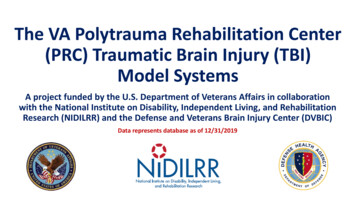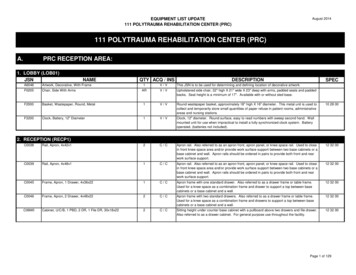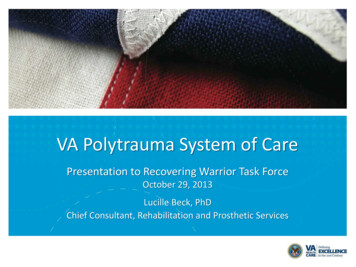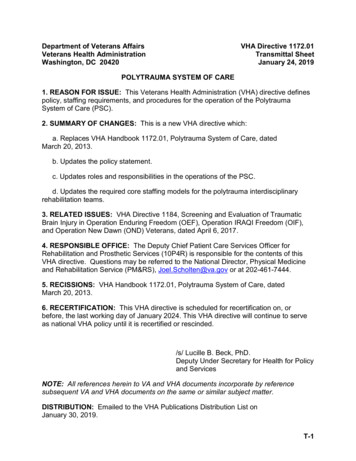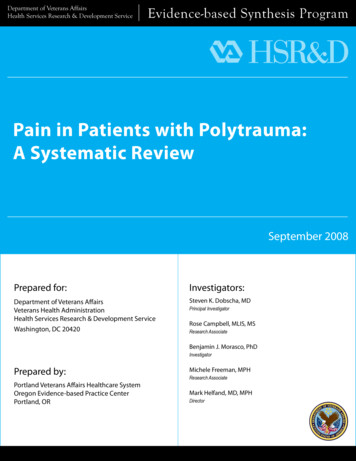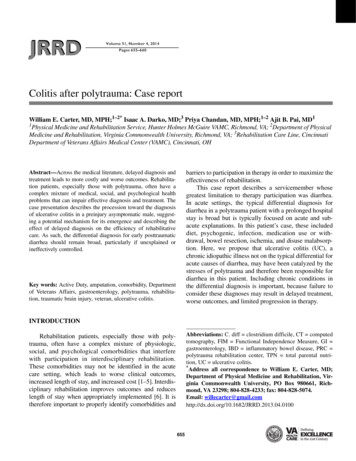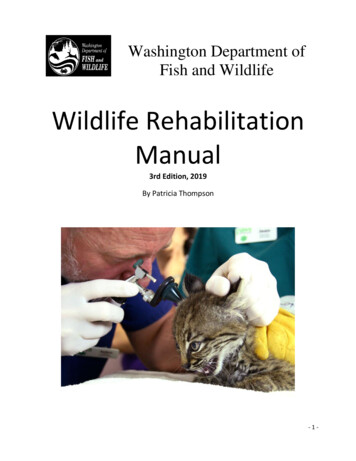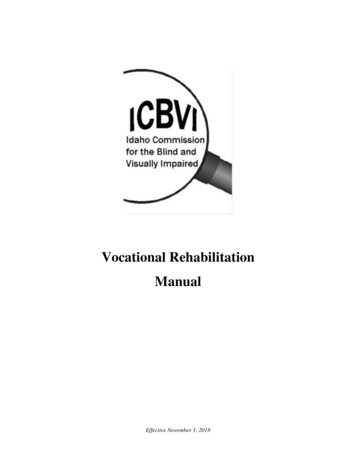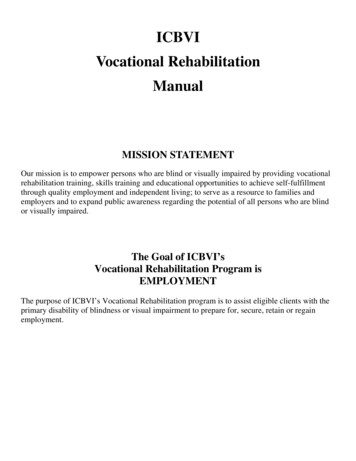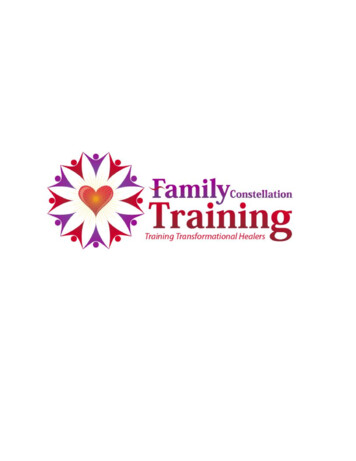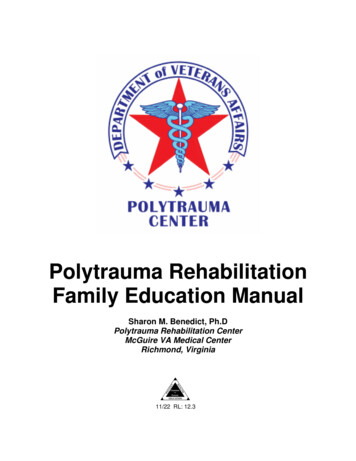
Transcription
Polytrauma RehabilitationFamily Education ManualSharon M. Benedict, Ph.DPolytrauma Rehabilitation CenterMcGuire VA Medical CenterRichmond, Virginia11/22 RL: 12.3
For questions or information about this manual, please contact:Dr. Sharon BenedictRehabilitation PsychologistPolytrauma Rehabilitation CenterMcGuire VA Medical CenterRichmond, VirginiaSharon.Benedict@va.gov(804) 675-5000 ext. 65722
INTRODUCTION:Welcome to the Polytrauma Rehabilitation Center (PRC) at the Richmond McGuire VAMedical Center. This manual is provided to you to help educate you about brain injury,brain injury rehabilitation and other related topics that may come up during your familymember’s stay at the PRC. The information included in this manual has been written andcompiled from several sources and is intended only as a general guide for families andfriends of patients with brain injuries. Please read the manual at your own pace. NOTE:To simplify the reading of this material the pronoun “he” has been used throughout thetext to represent individuals with brain injury, although we certainly recognize thatbrain injury is not gender-specific.For your convenience and to help make this information understandable, we haveincluded a “Glossary of Terms” at the end of the manual. Terms included in the Glossarycan be found throughout the pages in italics, also often followed by a definition.Additional information about the Polytrauma Rehabilitation Unit, the McGuire VAMCfacility and patient and family rights and responsibilities can be found in the PolytraumaRehabilitation Center Orientation Handbook for Patients and Families, which youreceived on or before admission.As you learn more about the brain and its functions, you are likely to have manyquestions. Members of our rehabilitation team are here to answer your questions and toprovide you with information about brain injury and recovery. Please use them as aresource. You may also find additional information related to brain injury by visitingthese websites: The Brain Injury Association of America: www.biausa.orgDefense and Veteran’s Brain Injury Center: www.dvbic.orgNational Institute of Neurological Disorders and htmCentre for Neuro Skills: TBI Resource Guide: www.neuroskills.comNational Resource Center for TBI: http://www.nrc.pmr.vcu.eduFor more information about outcomes data on the brain injury program at the RichmondPolytrauma Rehabilitation Center go to: http://www1.va.gov/netsix-braininjury/For information about military resources and service-specific benefits go to: Military OneSource: http://www.militaryonesource.com (800-342-9647) Army Wounded Warrior Program (AW2): https://www.aw2.army.mil (800-8336622 Marine For Life (M4L): https://www.m4l.usmc.mil (866-645-8762)3
Safe Harbor (Navy): (877-746-8563)Palace Hart (Air Force) (888-774-1361)4
PART I:EQUIPPING YOURSELF WITH KNOWLEDGETraumatic brain injury (TBI) affects not only the individual but the family as a whole.One minute the person is fine, the next minute he is involved in an overwhelming medicalemergency, perhaps a fight for life. As a family member, you are also involved in thiscomplex process. Even as the initial crisis passes, you are suddenly involved in makingsense of all the new and complicated situations in which you find yourselves. In order togain the confidence to make decisions about your family member’s care, it is importantto learn as much as possible about brain injury, and how it can affect a person’scognition (thinking) and behavior (acting).In addition to providing basic information about brain injury, this guide also offers someinformation about how treatment at our rehabilitation facility promotes the recoveryprocess and how we approach this treatment as an interdisciplinary team. Finally, wehave included information about some of the ways you can and should take care ofyourself during this difficult and challenging time.Please note that some of the information in this manual may not directly apply to yourfamily member - or to your experience thus far. No two people have the same braininjury, and so the recovery process and the long-term effects of an injury will vary foreach patient. This is important to remember when coming to know other patients andfamilies on our unit. Your family member’s recovery will be individualized and mayproceed more rapidly or slowly than other patients. Please try to avoid comparisonswhenever possible.WHAT ARE THE FUNCTIONS OF THE BRAIN?Though it weighs barely three pounds, the brain has an enormous job. It regulates all ofour physical movement and sensation as well as our ability to think, act, feel andcommunicate. Because the brain is such a complex organ, it is probably best to beginwith a basic explanation of its functions. This may help you to understand some of thechanges that you may observe in your family member over time.The brain is divided into several parts, each with very specific functions. Normally, thebrain manages to perform routine actions regularly and quickly through constantcommunication between one part of the brain and the next. When the brain in injured,communication between the different areas of the brain can become disrupted andinterrupt the simplest of tasks. Certain types of problems are commonly seen withinjury to specific parts of the brain. In fact, in some cases the areas of the brain thathave been damaged can be identified by changes in the individual’s behavior followinginjury. The best way to understand the deficits associated with brain injury is to5
understand the function of each area of the brain and its related systems andstructures (refer to picture below).SkullThe bones that come together to cover and protect the brain.Brain StemThe brain stem, located at the base of the skull, is a very small area that is responsiblefor life-sustaining functions such as regulation of blood pressure, heart rate, breathing,and body temperature. The system that is responsible for arousal and alertness is alsoin the brain stem and is known as the Reticular Activating System (RAS). The RASfunctions like a dimmer in a light switch, increasing and decreasing the responsivenessto the environment. If the RAS is damaged, an altered state of consciousness such ascoma or a vegetative state may result.CerebellumThe cerebellum, located behind the brain stem, is responsible for muscle coordinationand balance.Cerebral CortexThe cerebral cortex (cerebrum) is what is most commonly thought of as “the brain”. Itis divided into left and right hemispheres. Generally, each hemisphere directs theopposite side of the body (i.e., the left hemisphere directs the right side of the bodyand vice versa).6
Each hemisphere is then divided into four lobes that have specific functions:Frontal LobesParticularly vulnerable to trauma and necessary to higher level thinking, oftencalled “executive” functions. These functions include the ability to focusattention, organize and plan, problem-solve, make good decisions, and showappropriate judgment. Executive functions also play a role in controlling behaviorand emotions.Occipital LobesResponsible for aspects of visual function.Temporal LobesRegulate memory function, language information, aspects of emotional processing,and behavior.Parietal LobesImportant in sensation (touch, pressure, temperature, pain), perception, attentionand complex aspects of brain processing.Sensory & Motor StripsPrimarily responsible for organization of higher level motor behavior, such as thecoordination of movement in walking.Limbic System (located inside the temporal lobe)In addition to the different lobes of the brain, there are systems within it thatconnect these lobes. The limbic system is an area of vital importance to mood andemotional regulation, motivation, attention, and memory. Injury to this systemmay result in behaviors ranging from a). flat affect (no expression) toaggressiveness b). mild distractibility to the inability to pay attention and, c).slight memory problems to the inability to recall what happened 30 minutes ago.7
WHAT IS BRAIN INJURY AND WHAT HAPPENS TO THE BRAIN WHEN IT ISINJURED?Injury to the brain can occur when the head is injured by an external force (calledtraumatic brain injury or TBI) or by a non-traumatic event such as a tumor, stroke,aneurysm, or infection. Any brain injury can cause a wide range of functional changesthat may affect thinking, sensation, language, memory and/or emotions.Initial EventsThree initial events can occur following a brain injury. First, immediate damage canoccur if the brain hits or rubs against the bony structures of the skull, especially in thearea of the forehead (frontal area) and upper cheek and ear (temporal area). Thisimpact can cause tearing, bleeding, and bruising of brain tissue. Second, the brain isfixed to the spinal cord and as it turns and twists during injury tearing and stretchingof the nerve fibers (axons) can occur all over the brain and in the brain stem. Third, thebrain can suffer diffuse (all over) swelling which, in 75 percent of cases, will result in anincrease in intracranial pressure, due to the inability of the skull to expand. Generalswelling and increased pressure reduces the blood flow necessary for undamaged braintissue to function properly. Unconsciousness or coma may result, depending on theseverity of these injuries.The type of injuries described thus far generally occur in the minutes, hours and initialdays after the injury. Once brain swelling is reduced and blood flow returns to normal,the extent to which the brain tissue has been damaged becomes clearer. Some braintissue may return to normal functioning. Other tissue may be permanently damaged.Categories of Brain InjuryBrain injuries range from “mild” to “severe” and are categorized as penetrating (open)or non-penetrating (closed). A brain injury is classified as a traumatic brain injury orTBI when the injury to the brain is caused by an external force. TBIs can be caused bypenetrating or non-penetrating injuries. A penetrating TBI means the skull has beenpunctured or opened in some way as in the case of injury caused by shrapnel or gunshotwound. In a non-penetrating TBI, the head is shaken or hit by an external force whichcauses the brain to impact against the boney structure of the skull (e.g., exposure to ablast, fall or motor vehicle accident).The brain can also sustain injury from non-traumatic events such as anoxia (insufficientoxygen to the brain), aneurysm (burst blood vessel) or stroke. Brain injury from anycause can result in one or more of the following:8
contusion: a bruise to a part of the brainlaceration: a ragged tear in the tissue of the brainhemorrhage: bleeding following damage to the blood vesselsA hemorrhage may eventually develop into a hematoma (a blood clot) and can occur in anypart of the brain. Clots fill the space between the skull and the brain and put pressureon the brain. The most common forms of hemorrhage are:epidural hemorrhage: forms between the dura (tissue which covers andprotects the brain) and the skullsubdural hemorrhage: forms between the brain and the durasubarachnoid hemorrhage: forms in between the layers of membranescovering the brainintraventricular hemorrhage: blood that enters the open spaces (ventricles)of the brainDamage to the brain from either an open or closed injury may be focal, meaning aspecific area of the brain is affected, or diffuse, meaning brain cells in many areas ofthe brain are affected. A patient with a brain injury may suffer from both diffuse andfocal injuries.AnoxiaBecause brain cells need a constant supply of blood to provide them with oxygen andnutrients, any interruption in this supply can cause damage. Insufficient oxygen to thebrain is called anoxia. An anoxic injury can follow several events including, heart attack,complications of anesthesia or respiratory failure.Diffuse Axonal Injury (DAI) is widespread damage to the axons or communicationpathways that connect the different areas of the brain. This occurs when there istwisting and turning of the brain tissue at the time of injury. Consequently, brainmessages are slowed down or lost and there is a reduction in the number of cognitiveoperations that the brain can engage in at any given time.Rancho Los Amigos ScaleThe Rancho Los Amigos Scale is an instrument used to track recovery from brain injury.It is most helpful in assessing the patient in the first weeks or months following theinjury, because it does not require the cooperation of the patient. The Rancho Levelsare based upon observations of the patient's responses to the world around him. Theyprovide insight into the expected progression during recovery and rehabilitation.An understanding of the characteristics of each of the eight Rancho Levels (see scalebelow) is helpful when families must cope with the behaviors demonstrated by theirfamily member following head injury.9
Level I – No response. Patient does not respond to external stimuli and appearsasleep. Level II – Generalized response. Patient reacts to external stimuli in nonspecificand inconsistent manner with stereotypic (repeated, purposeless movements) andlimited responses Level III – Localized response. Patient responds specifically and inconsistentlywith delays to stimuli, but may follow simple commands for motor action. Level IV – Confused, agitated response. Patient exhibits bizarre, non-purposeful,incoherent or inappropriate behaviors, no short-term recall; attention is shortand nonselective. Level V – Confused, inappropriate, non-agitated response. Patient gives random,fragmented and non-purposeful responses to complex or unstructured stimuli.Simple commands are followed consistently, memory and selective attention areimpaired and new information is not retained. Level VI – Confused, appropriate response. Patient gives context- appropriate,goal-directed responses, dependent upon external input for direction. There iscarry-over for relearned, but not for new tasks, and recent memory problemspersist. Level VII – Automatic, appropriate response. Patient behaves appropriately infamiliar settings, performs daily routines automatically, and shows carry-over fornew learning at lower than normal rates. Patient initiates social interactions, butjudgment remains impaired. Level VIII – Purposeful, appropriate response. Patient is oriented and respondsto the environment but abstract reasoning abilities are decreased compared topre-morbid (before the injury) levels.MEDICAL AND RELATED PHYSICAL EFFECTS OF BRAIN INJURYMany potential deficits are discussed in the following four sections. Remember as youread these descriptions that only some may apply to your family member. As notedearlier, each person’s injury and path to recovery is unique.Problems with nutrition, swallowing and eatingPhysical and cognitive changes such as diminished attention, poor hand coordination, anddifficulty in swallowing, can disrupt normal eating habits. Proper nutrition is essential to10
healing so evaluations are performed to determine the best means for your familymember to maintain adequate nutrition. Retraining efforts by nursing, occupationaltherapy, and speech therapy can help a person recover eating abilities.Dysphagia is a term used to describe swallowing disorders. After a brain injury, apatient may aspirate (inhale) food or liquids into the lungs. Sometimes a patient canaspirate without choking or coughing (silent aspiration). Aspiration can cause pneumoniato develop, which can be a life threatening condition. Speech/language pathologistsconduct evaluations to determine a person’s level of safety in swallowing. Some patientsmay require a feeding tube to help maintain proper nutrition until they are able toswallow properly again. Several feeding tubes are common:nasogastric (NG) tube: does not require a surgical procedure for useand is passed through the patient’s nose and into the stomachjejunostomy (J) tube: surgically inserted directly into the smallintestinegastrostomy (G) tube: inserted directly into the stomach.NOTE: It is very important that you DO NOT feed or offer liquid to your familymember until given clearance by the medical team.FeverIf fever occurs, blood and urine tests and x-rays may be needed to help discover thecause of the fever. Fevers are most often caused by infections (e.g., urinary tract) orpneumonia and, typically, can be easily treated with antibiotics. Fevers are alsooccasionally due to actual damage or dysfunction of the brain area that controlstemperature.FracturesMany individuals who suffer a brain injury also sustain other trauma such as fracturedbones. Orthopedic care can continue in the rehabilitation setting and rehabilitationspecialists (physical therapists, kinesiotherapists) can assist in recovery from theeffects of these injuries. Often, activities will be restricted for a period to allow forproper healing. NOTE: After brain injury, a patient may not understand activityrestrictions or the need for them. For their safety, it is up to the treatment team ANDfamily to monitor the patient’s activity level and to continually reinforce anyrestrictions.Heterotropic OssificationMany patients with severe brain injury develop extra bone in the soft tissue aroundtheir joints — usually shoulders, elbows, knees, and hips. This formation, calledheterotopic ossification, can cause pain and diminish the range of motion (ROM) in theaffected joints. Range of motion therapy can help to lessen the problem and may beused along with medication. In more severe cases, future surgery may be necessary.11
HydrocephalusCerebrospinal fluid (CSF) is like a “shock absorber” for the brain. CSF fluid circulatesaround the brain and spinal cord and acts as a protective cushion against physicalimpact. The amount of CSF in the skull must be maintained at a certain volume for thebrain to function normally. Hydrocephalus is a condition in which there is too much CSFin the skull. This condition causes the enlargement of the four cerebral ventricles(connected hollow spaces in the brain) that help to produce, filter, and distribute theCSF. Hydrocephalus can be caused by an abnormal production of CSF or by anobstruction that does not allow the fluid to circulate properly. In some cases, a smallcatheter or shunt may be required to drain excess fluid from the brain.Bladder and Bowel IncontinenceIt is common for brain injury survivors to temporarily lose control of bowel and bladderfunctions, particularly early in recovery when their overall awareness is diminished. Inaddition, pain medications often cause problems with constipation. Functional problemswith bowel and bladder may persist even after the patient regains awareness, if there isdamage to the areas of the brain that control those muscles. Bowel and bladderprograms can be implemented during rehab to improve function. Management techniquesinclude laxatives and/or suppositories, use of catheters or external collecting devicesand scheduled times and reminders for voiding. Bowel and bladder functions also may beimproved by changes in diet.Problems of InactivityThe long period of inactivity that often accompanies recovery from a brain injury canalso lead to certain physical problems. General deconditioning is a condition where anindividual’s strength and energy gradually decreases due to extended bed rest.Individual exercise programs can help restore lost muscle strength and physicalendurance. Skin problems such as pressure ulcers can develop after lying in one positionfor a long time. The best prevention of pressure sores is frequent inspection of theskin, shifting and repositioning, and good nutritional status. Blood clots, called deep veinthrombosis (DVT) may develop, especially in the legs, when patients have limited abilityto move. Although the clots are not always apparent, they may be accompanied by p
Welcome to the Polytrauma Rehabilitation Center (PRC) at the Richmond McGuire VA Medical Center. This ma
